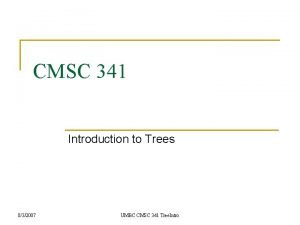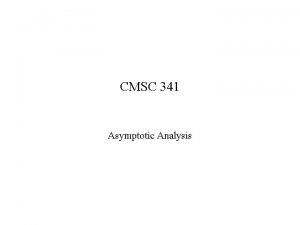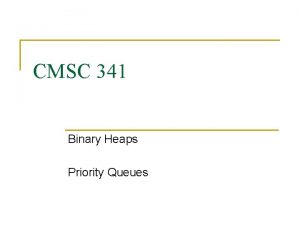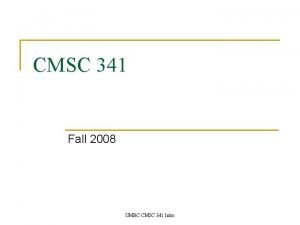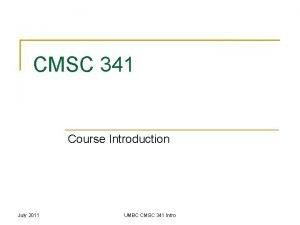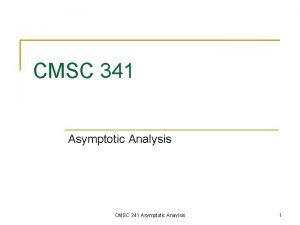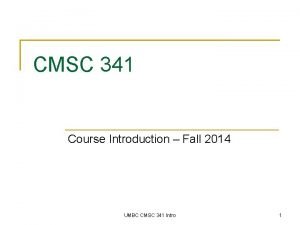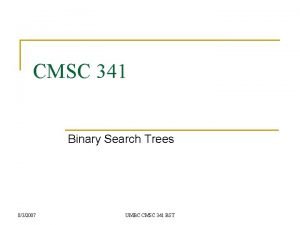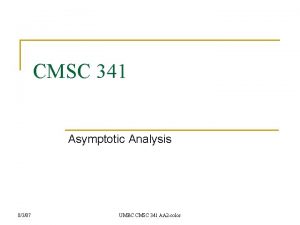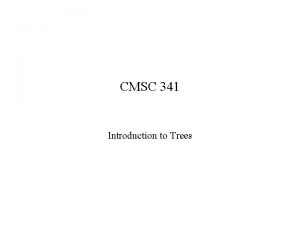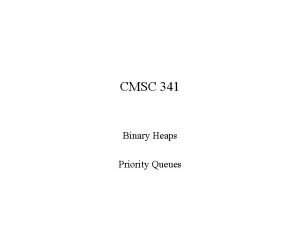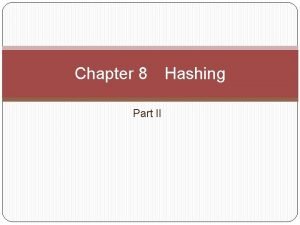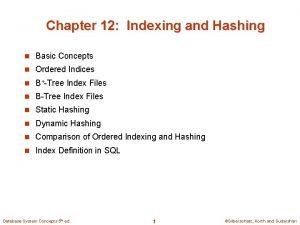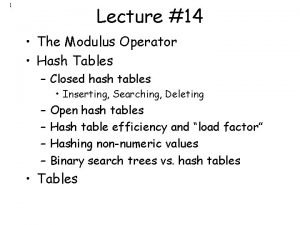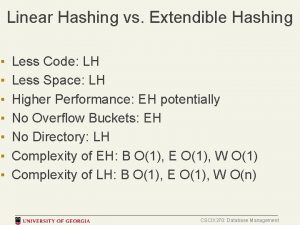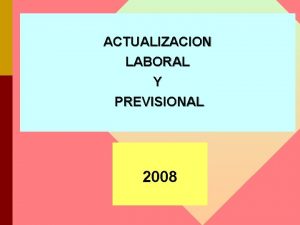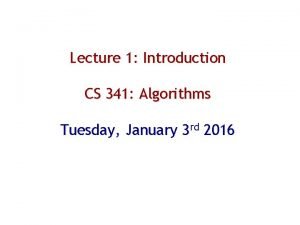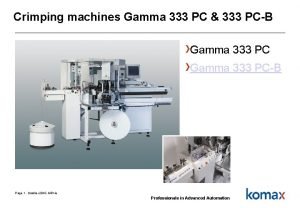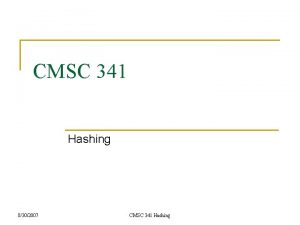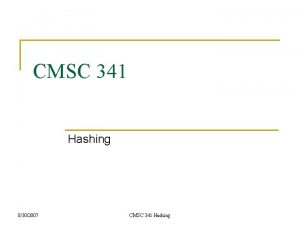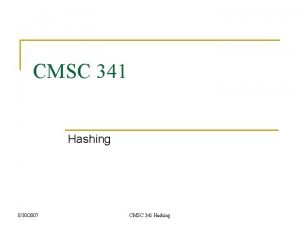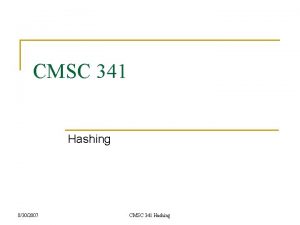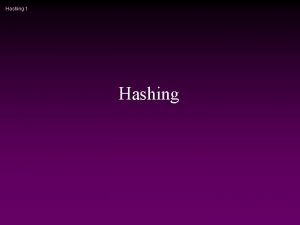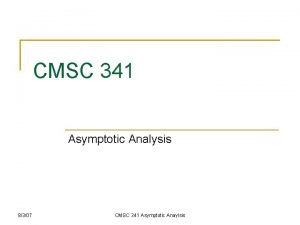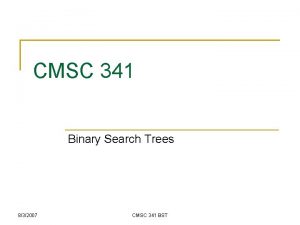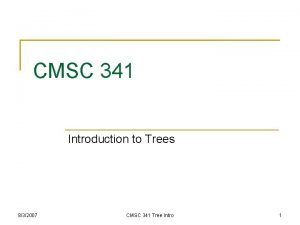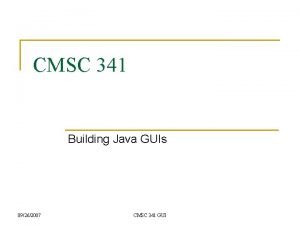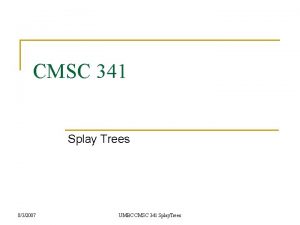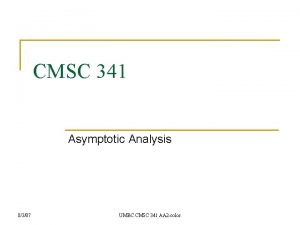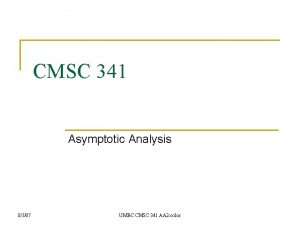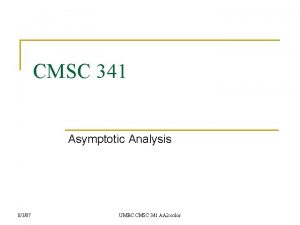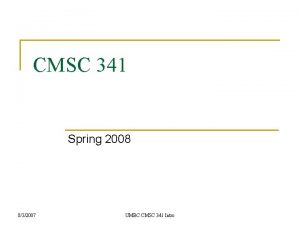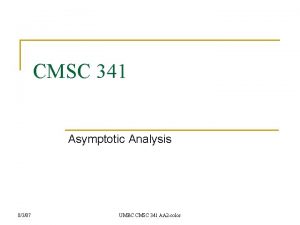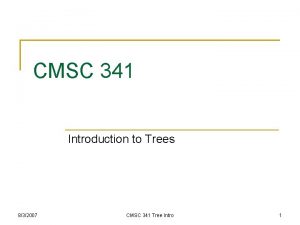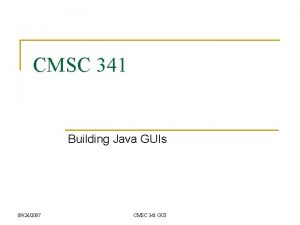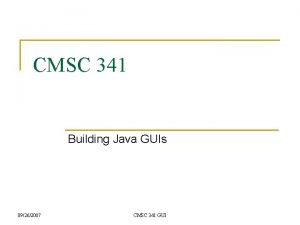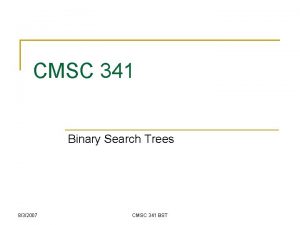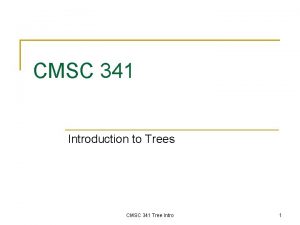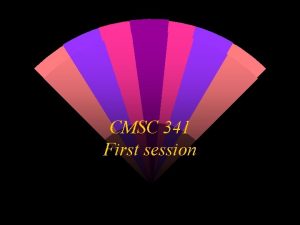CMSC 341 Hashing 8302007 CMSC 341 Hashing The

























- Slides: 25

CMSC 341 Hashing 8/30/2007 CMSC 341 Hashing

The Basic Problem n We have lots of data to store. n We desire efficient – O( 1 ) – performance for insertion, deletion and searching. n Too much (wasted) memory is required if we use an array indexed by the data’s key. n The solution is a “hash table”. 8/30/2007 CMSC 341 Hashing 2

Hash Table 0 n 2 m-1 Basic Idea q q n 1 The hash table is an array of size ‘m’ The storage index for an item determined by a hash function h(k): U {0, 1, …, m-1} Desired Properties of h(k) q q easy to compute uniform distribution of keys over {0, 1, …, m-1} n 8/30/2007 when h(k 1) = h(k 2) for k 1, k 2 U , we have a collision CMSC 341 Hashing 3

Division Method n The hash function: h( k ) = k mod m where m is the table size. n m must be chosen to spread keys evenly. q q n n Poor choice: m = a power of 10 Poor choice: m = 2 b, b> 1 A good choice of m is a prime number. Table should be no more than 80% full. q 8/30/2007 Choose m as smallest prime number greater than mmin, where mmin = (expected number of entries)/0. 8 CMSC 341 Hashing 4

Multiplication Method n The hash function: h( k ) = m( k. A - k. A ) where A is some real positive constant. n n n A very good choice of A is the inverse of the “golden ratio. ” Given two positive numbers x and y, the ratio x/y is the “golden ratio” if = x/y = (x+y)/x The golden ratio: x 2 - xy - y 2 = 0 = (1 + sqrt(5))/2 ~= Fibi/Fibi-1 8/30/2007 2 - - 1 = 0 = 1. 618033989… CMSC 341 Hashing 5

Multiplication Method (cont. ) n Because of the relationship of the golden ratio to Fibonacci numbers, this particular value of A in the multiplication method is called “Fibonacci hashing. ” n Some values of h( k ) = m(k -1 - k -1 ) =0 = 0. 618 m = 0. 236 m = 0. 854 m = 0. 472 m = 0. 090 m = 0. 708 m = 0. 326 m =… = 0. 777 m 8/30/2007 for k = 0 for k = 1 ( -1 = 1/ 1. 618… = 0. 618…) for k = 2 for k = 3 for k = 4 for k = 5 for k = 6 for k = 7 for k = 32 CMSC 341 Hashing 6

8/30/2007 CMSC 341 Hashing 7

Non-integer Keys n n n In order to have a non-integer key, must first convert to a positive integer: h( k ) = g( f( k ) ) with f: U integer g: I {0. . m-1} Suppose the keys are strings. How can we convert a string (or characters) into an integer value? 8/30/2007 CMSC 341 Hashing 8

Horner’s Rule static int hash(String key, int table. Size) { int hash. Val = 0; for (int i = 0; i < key. length(); i++) hash. Val = 37 * hash. Val + key. char. At(i); hash. Val %= table. Size; if(hash. Val < 0) hash. Val += table. Size; return hash. Val; } 8/30/2007 CMSC 341 Hashing 9

Hash. Table Class public class Separate. Chaining. Hash. Table<Any. Type> { public Separate. Chaining. Hash. Table( ){/* Later */} public Separate. Chaining. Hash. Table(int size){/*Later*/} public void insert( Any. Type x ){ /*Later*/ } public void remove( Any. Type x ){ /*Later*/} public boolean contains( Any. Type x ){/*Later */} public void make. Empty( ){ /* Later */ } private static final int DEFAULT_TABLE_SIZE = 101; private List<Any. Type> [ ] the. Lists; private int current. Size; private void rehash( ){ /* Later */ } private int myhash( Any. Type x ){ /* Later */ } private static int next. Prime( int n ){ /* Later */ } private static boolean is. Prime( int n ){ /* Later */ } } 8/30/2007 CMSC 341 Hashing 10

Hash. Table Ops n boolean contains( Any. Type x ) q n void insert (Any. Type x) q q n If x already in table, do nothing. Otherwise, insert it, using the appropriate hash function. void remove (Any. Type x) q q n Returns true if x is present in the table. Remove the instance of x, if x is present. Ptherwise, does nothing void make. Empty() 8/30/2007 CMSC 341 Hashing 11

Hash Methods private int myhash( Any. Type x ) { int hash. Val = x. hash. Code( ); hash. Val %= the. Lists. length; if( hash. Val < 0 ) hash. Val += the. Lists. length; return hash. Val; } 8/30/2007 CMSC 341 Hashing 12

Handling Collisions n n Collisions are inevitable. How to handle them? Separate chaining hash tables q q n Insertion of key k q q n Store colliding items in a list. If m is large enough, list lengths are small. hash( k ) to find the proper list. If k is in that list, do nothing, else insert k on that list. Asymptotic performance q 8/30/2007 If always inserted at head of list, and no duplicates, insert = O(1) for best, worst and average cases CMSC 341 Hashing 13

Hash Class for Separate Chaining n To implement separate chaining, the private data of the hash table is an array of Lists. The hash functions are written using List functions private List<Any. Type> [ ] the. Lists; 8/30/2007 CMSC 341 Hashing 14

Performance of contains( ) n contains q q n Hash k to find the proper list. Call contains( ) on that list which returns a boolean. Performance q best: q worst: q average 8/30/2007 CMSC 341 Hashing 15

Performance of remove( ) n Remove k from table q q n Hash k to find proper list. Remove k from list. Performance q best q worst q average 8/30/2007 CMSC 341 Hashing 16

Handling Collisions Revisited n Probing hash tables q q n All elements stored in the table itself (so table should be large. Rule of thumb: m >= 2 N) Upon collision, item is hashed to a new (open) slot. Hash function h: U x {0, 1, 2, …. } {0, 1, …, m-1} h( k, i ) = ( h’( k ) + f( i ) ) mod m for some h’: U { 0, 1, …, m-1} and some f( i ) such that f(0) = 0 n Each attempt to find an open slot (i. e. calculating h( k, i )) is called a probe 8/30/2007 CMSC 341 Hashing 17

Hash. Entry Class for Probing Hash Tables n In this case, the hash table is just an array private static class Hash. Entry<Any. Type>{ public Any. Type element; // the element public boolean is. Active; // false if deleted public Hash. Entry( Any. Type e ) { this( e, true ); } public Hash. Entry( Any. Type e, boolean active ) { element = e; is. Active = active; } } // The array of elements private Hash. Entry<Any. Type> [ ] array; // The number of occupied cells private int current. Size; 8/30/2007 CMSC 341 Hashing 18

Linear Probing n n Use a linear function for f( i ) = c * i Example: h’( k ) = k mod 10 in a table of size 10 , f( i ) = i So that h( k, i ) = (k mod 10 + i ) mod 10 Insert the values U={89, 18, 49, 58, 69} into the hash table 8/30/2007 CMSC 341 Hashing 19

Linear Probing (cont. ) n Problem: Clustering q n When the table starts to fill up, performance O(N) Asymptotic Performance q Insertion and unsuccessful find, average n n n 8/30/2007 is the “load factor” – what fraction of the table is used Number of probes ( ½ ) ( 1+1/( 1 - )2 ) if 1, the denominator goes to zero and the number of probes goes to infinity CMSC 341 Hashing 20

Linear Probing (cont. ) n Remove q q Can’t just use the hash function(s) to find the object and remove it, because objects that were inserted after X were hashed based on X’s presence. Can just mark the cell as deleted so it won’t be found anymore. n n 8/30/2007 Other elements still in right cells Table can fill with lots of deleted junk CMSC 341 Hashing 21

Quadratic Probing n n Use a quadratic function for f( i ) = c 2 i 2 + c 1 i + c 0 The simplest quadratic function is f( i ) = i 2 Example: Let f( i ) = i 2 and m = 10 Let h’( k ) = k mod 10 So that h( k, i ) = (k mod 10 + i 2 ) mod 10 Insert the value U={89, 18, 49, 58, 69 } into an initially empty hash table 8/30/2007 CMSC 341 Hashing 22

Quadratic Probing (cont. ) n Advantage: q n Reduced clustering problem Disadvantages: q q q 8/30/2007 Reduced number of sequences No guarantee that empty slot will be found if λ ≥ 0. 5, even if m is prime If m is not prime, may not find an empty slot even if λ < 0. 5 CMSC 341 Hashing 23

Double Hashing n Let f( i ) use another hash function f( i ) = i * h 2( k ) Then h( k, I ) = ( h’( k ) + * h 2( k ) ) mod m And probes are performed at distances of h 2( k ), 2 * h 2( k ), 3 * h 2( k ), 4 * h 2( k ), etc n Choosing h 2( k ) q q n Don’t allow h 2( k ) = 0 for any k. A good choice: h 2( k ) = R - ( k mod R ) with R a prime smaller than m Characteristics q q 8/30/2007 No clustering problem Requires a second hash function CMSC 341 Hashing 24

Rehashing n n n If the table gets too full, the running time of the basic operations starts to degrade. For hash tables with separate chaining, “too full” means more than one element per list (on average) For probing hash tables, “too full” is determined as an arbitrary value of the load factor. To rehash, make a copy of the hash table, double the table size, and insert all elements (from the copy) of the old table into the new table Rehashing is expensive, but occurs very infrequently. 8/30/2007 CMSC 341 Hashing 25
 Cmsc 341
Cmsc 341 Cmsc 341
Cmsc 341 Cmsc 341
Cmsc 341 Umbc cmsc 341
Umbc cmsc 341 Umbc cmsc 202
Umbc cmsc 202 Cmsc 341
Cmsc 341 Cmsc student portal
Cmsc student portal Cmsc 341 umbc
Cmsc 341 umbc Cmsc 341
Cmsc 341 Cmsc 341
Cmsc 341 Cmsc 341
Cmsc 341 Motivation for dynamic hashing
Motivation for dynamic hashing Static hashing and dynamic hashing
Static hashing and dynamic hashing Modulo function c++
Modulo function c++ Distinguish between extendible and linear hashing
Distinguish between extendible and linear hashing Mgmt 341
Mgmt 341 Ecma-341
Ecma-341 Actualizacion 341
Actualizacion 341 341 ces
341 ces Ncg 341
Ncg 341 How to round to nearest hundred thousand
How to round to nearest hundred thousand Acer xr
Acer xr Cs350 uwaterloo
Cs350 uwaterloo Pc 333
Pc 333 Oui par ton sang lave mon coeur
Oui par ton sang lave mon coeur Sda hymn 341
Sda hymn 341
